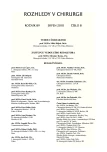Syndroma Caudae Equinae of Rare Etiology
Authors:
I. Lukáč; I. J. Šulla
Authors‘ workplace:
Neurochirurgická klinika UPJŠ LF Košice, Slovenská republika
prednosta: doc. MUDr. M. Gajdoš, CSc. – mim. prof.
Published in:
Rozhl. Chir., 2010, roč. 89, č. 8, s. 522-527.
Category:
Monothematic special - Original
Overview
The results of treatment patients suffering from syndroma caudae equinae (SCE) are not generally satisfactory. The authors decided to evaluate occurrence according to etiology and permanent conseguences after treatment in patients that were treated at the Department of Neurosurgery P. J. Šafarik University Hospital in Košice during 12 years (1996–2007). 95 patients from the 101 members file had SCE caused by disc herniation or spinal stenosis. Rare etiology of SCE was found in the six cases: three had traumatic origin, one spinal epidural abscess, one tumor. SCE developped after surgery of intervetebral disc herniation in one patient.
Patients underwent control examination or answered by a questionnaire one year from the beginning of SCE or later. Three patients with traumatic SCE had the moderate residual problems. One patient suffered from intermitent pain, perianogenital hypesthesia had two patients, light motor deficit another one. One patient needs to use increased abdominal pressure for urination. Nobody from this subgroup had sexual difficulties or problems with anal spincters’ control. The result of treatment patient with SCE caused by spinal epidural absces was unfavourable. Permanent pain, perianogenital hypesthesia, hard motor deficit and loss of sexual functions persisted.
Patient with oncological SCE had deficit in every traced signs. Similar clinical picture was in a patient with postoperative SCE, but residual deficit was moderate.
Key words:
syndroma caudae equinae – parmanent consequences
Sources
1. Šulla, I., Balík, V., Výrostko, J. Platničkový syndrom cauda equina a jeho vplyv na pracovnú schopnosť. Praktická medicína, 2008; 2(3): 32–34.
2. Orendáčová, J., Čížková, D., Kafka, J., Lukáčová, N., Maršala, M., Šulla, I. et al. Cauda equina syndrome. Progress in Neurobiology, 2001; 64 : 613–637.
3. DeLong, W. B., Polissar, N., Neradilek, B. Timing of surgery in cauda equina syndrome with Urinary retention: meta analysis of observational studies. J. Neurosurg. Spine, 2008; 8 : 305–320.
4. Náhlovský, J. Neurochirurgie. 1. vyd. Praha, Galén, 2006 : 581.
5. Šulla, I. jr., Vanický, I., Danko, J. Pokus o vysvetlenie neuspokojivých výsledkov po operáciach pre syndróm cauda equina. Experimentálna štúdia. Acta Spondilologica, 2004; 3 : 44–48.
6. Šulla, I. J., Lukáč, I., Šulla, I. jr. Syndroma caudae equinae discogenes. 1st ed. Košice, UPJŠ, 2009.
7. Cohen, D. B. Infectious origins of cauda equina syndrome. Neurosurg. Focus, 2004; 16 : 5–10.
8. DeKruik, J., Korten, A., Boiten, J., Wilmink, J. Acute cauda equina syndrome caused by thrombosis of the inferior vena cava. J. Neurol. Neurosurg. Psychiat., 1999; 67 : 827–828.
9. Loo, C. C., Irestedt, L. Cauda equina syndome after spinal anaesthesia with hyperbaric 5% lidocaine: A review of sixs cases of cauda equinq syndrome reported to the Swedish pharmateutical insurance 1993–1997. Acta Anaesthesiol. Scand., 1999; 43 : 371–379.
10. Bagley, C. A., Gokaslan, Z. L. Cauda equina syndrome caused by primary and metastatic neoplasms. Neurosurg. Focus, 2004; 16 : 11–18.
11. Were, G. D., Dean, C. L., Who, S., Ahn, U. M., Cassinelli, E. H., Liu, R. W. Cauda equina syndrome resulting from treatment of dural ectasia with fibrin glue injection. J. Spinal Disord. Tech., 2006; 19 : 148–150.
12. Gajdoš, M., Leško, J., Cicholesová, T. Ochorenia driekovej chrbtice – 1. časť: všeobecné poznámky, klinika, diagnostika, konzervatívna liečba. Praktická medicína, 2008; 2(3): 30–31.
13. Molina-Guzmán, A. A.,Gonzáles Miranda, M. T., Aranda, Esquivel, O. A. Complex sacral frac ture treated with dynaamic compression plates: a case report. Acta Ortop. Mex., 2008; 22(3): 204–209.
14. Beaulé, P. E., Antoniades, J., Matta, J. M. Trans-sacral fixation for failed posterior fixation of the pelvic ring. Arch. Orthop. Trauma Surg., 2006; 126(1): 49–52.
15. Griffin, D. R., Starr, A. J., Reinert, C. M., Jones, A. L., Whitlock, S. Vertically unstable pelvic fractures: does posterior injury pattern predict fixation failure? J. Orthop. Trauma, 2003; 17(6): 399–405.
16. Tosounidis, G., Culemann, U., Wirbel, R., Holstein, J. H., Pohlemann, T. Percutaneous sacroiliac lag screw fixation of the posterior pelvic ring. Increasing safety by standardisation of visualisation and insertion technique. Unfallchirurg, 2007; 110(8): 669–674.
17. Taller, S., Lukáš, R., Suchomel, P., Krivohlávek, M. Surgical treatment of dislocated transverse fractures of the sacrum. Acta Chir. Orthop. Traumatol. Cech, 2003; 70(3): 151–157.
18. Day, C. S., Prayson, M. J., Shuler, T. E., Towers, J., Gruen, G. S. Transsacral versus modified pelvic landmarks for percutaneous iliosacral screw placement – a computed tomographic analysis and cadaveric study. Am. J. Orthop., 2000; 29(Suppl. 9): 16–21.
19. Schildhauer, T. A., Bellabarba, C., Nork, S. E., Barei, D. P., Routt, M. L. jr., Chapman, J. R. Decompression and lumbopelvic fixation for sacral fracture-dislocation with spino-pelvic dissociation. J. Orthop. Trauma, 2007; 20 : 447–457.
20. Greenberg, M. S. Handbook of Neurosurgery. 5th edition. New York, Thieme, 2001; 971 : 909–910.
Labels
Surgery Orthopaedics Trauma surgeryArticle was published in
Perspectives in Surgery

2010 Issue 8
- Metamizole at a Glance and in Practice – Effective Non-Opioid Analgesic for All Ages
- Possibilities of Using Metamizole in the Treatment of Acute Primary Headaches
- Metamizole in perioperative treatment in children under 14 years – results of a questionnaire survey from practice
Most read in this issue
- Syndroma Caudae Equinae of Rare Etiology
- Possibilities and Results of Surgical Treatment of Benign Tracheoesophageal Fistula
- How Long to Wait with Operations for Necrotizing Pancreatitis?
- Urgent Thyroidectomy for a Mechanical Syndrome Caused by a Toxic Nodular Goiter – A Case Report
